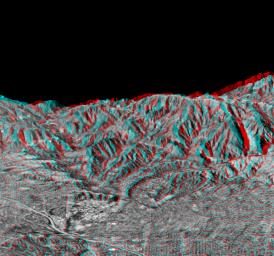This anaglyph is a perspective view that shows the western part of the city of Pasadena, California, looking north toward the San Gabriel Mountains. Red-blue glasses are required to see the 3-D effect. Portions of the cities of Altadena and La Canada-Flintridge are also shown. The image was created from two datasets: the Shuttle Radar Topography Mission (SRTM) supplied the elevation data and U. S. Geological Survey digital aerial photography provided the image detail. The Jet Propulsion Laboratory is the cluster of large buildings left of center, at the base of the mountains. This image shows the power of combining data from different sources to create planning tools to study problems that affect large urban areas. In addition to the well-known earthquake hazards, Southern California is affected by a natural cycle of fire and mudflows. Wildfires can strip the mountains of vegetation, increasing the hazards from flooding and mudflows. Data shown in this image can be used to predict both how wildfires spread over the terrain and how mudflows are channeled down the canyons.
This anaglyph was generated using topographic data from the Shuttle Radar Topography Mission to create two differing perspectives of a single image, one perspective for each eye. Each point in the image is shifted slightly, depending on its elevation. When viewed through special glasses, the result is a view of the Earth's surface in its full three dimensions. Anaglyph glasses cover the left eye with a red filter and cover the right eye with a blue filter.
The Shuttle Radar Topography Mission (SRTM), launched on February 11, 2000, uses the same radar instrument that comprised the Spaceborne Imaging Radar-C/X-Band Synthetic Aperture Radar (SIR-C/X-SAR) that flew twice on the Space Shuttle Endeavour in 1994. The mission is designed to collect three-dimensional measurements of the Earth's surface. To collect the 3-D data, engineers added a 60-meter-long (200-foot) mast, an additional C-band imaging antenna and improved tracking and navigation devices. The mission is a cooperative project between the National Aeronautics and Space Administration (NASA), the National Imagery and Mapping Agency (NIMA) and the German (DLR) and Italian (ASI) space agencies. It is managed by NASA's Jet Propulsion Laboratory, Pasadena, CA, for NASA's Earth Science Enterprise, Washington, DC.
Size: 5.8 km (3.6 miles) x 10 km (6.2 miles)
Location: 34.16 deg. North lat., 118.16 deg. West lon.
Orientation: Looking North
Original Data Resolution: SRTM, 30 m; aerial photo, 3 m; no vertical exaggeration
Date Acquired: February 16, 2000
Image: NASA/JPL/NIMA

 Planetary Data System
Planetary Data System












